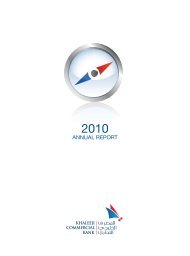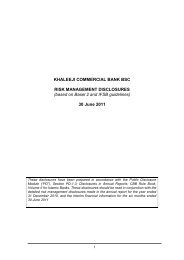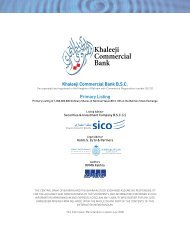2011 Annual Report - Khaleeji Commercial Bank BSC
2011 Annual Report - Khaleeji Commercial Bank BSC
2011 Annual Report - Khaleeji Commercial Bank BSC
Create successful ePaper yourself
Turn your PDF publications into a flip-book with our unique Google optimized e-Paper software.
KHALEEJI COMMERCIAL BANK <strong>BSC</strong><br />
NOTES TO THE CONSOLIDATED FINANCIAL STATEMENTS<br />
for the year ended 31 December <strong>2011</strong><br />
2. SIGNIFICANT ACCOUNTING POLICIES (continued)<br />
e. Investment securities (continued)<br />
(iii) Measurement<br />
Investment securities are measured initially at fair value, which is the value of the consideration given. For FVTIS<br />
investments, transaction costs are expensed in the income statement. For other investment securities, transaction costs<br />
are included as a part of the initial recognition.<br />
Subsequent to initial recognition, investments carried at FVTIS and FVTE are re-measured to fair value. Gains and<br />
losses arising from a change in the fair value of investments carried at FVTIS are recognised in the income statement in<br />
the period in which they arise. Gains and losses arising from a change in the fair value of investments carried at FVTE<br />
are recognised in the consolidated statement of changes in equity and presented in a separate fair value reserve within<br />
equity. The fair value gains / losses are recognised taking into consideration the split between portions related to owners’<br />
equity and equity of investment account holders. When the investments carried at FVTE are sold, impaired, collected<br />
or otherwise disposed of, the cumulative gain or loss previously recognised in the statement of changes in equity is<br />
transferred to the income statement.<br />
Investments at FVTE where the entity is unable to determine a reliable measure of fair value on a continuing basis, such<br />
as investments that do not have a quoted market price or other appropriate methods from which to derive reliable fair<br />
values, are stated at cost less impairment allowances.<br />
Subsequent to initial recognition, debt type investments, other than those carried at FVTIS, are measured at amortised<br />
cost using the effective profit method less any impairment allowances.<br />
(iv) Measurement principles<br />
Amortised cost measurement<br />
The amortised cost of a financial asset or liability is the amount at which the financial asset or liability is measured at initial<br />
recognition, minus capital repayments, plus or minus the cumulative amortisation using the effective profit method of<br />
any difference between the initial amount recognised and the maturity amount, minus any reduction (directly or through<br />
use of an allowance account) for impairment or uncollectability. The calculation of the effective profit rate includes all<br />
fees and points paid or received that are an integral part of the effective profit rate.<br />
Fair value measurement<br />
Fair value is the amount for which an asset could be exchanged, or a liability settled, between knowledgeable, willing<br />
parties in an arm’s length transaction on the measurement date. The Group measures the fair value of quoted investments<br />
using the market bid-prices in an active market for that instrument.<br />
For certain unquoted investments, the Group uses proprietary models, which usually are developed from recognised valuation<br />
models for fair valuation. Some or all of the inputs into these models may not be market observable, but are estimated based<br />
on assumptions. Inputs to valuation techniques reasonably represent market expectations and measures of the risk-return<br />
factors inherent in the financial instrument. Valuation adjustments are recorded to allow for bid-ask spreads, liquidity risks, as<br />
well as other factors. Management believes that these valuation adjustments are necessary and appropriate to fairly state the<br />
values of these investments.<br />
f. Financing assets<br />
Financing assets comprise Shari’a compliant financing contracts with fixed or determinable payments. These include financing<br />
provided through Murabaha, Musharaka, Istisna and Wakala contracts. Financing assets are recognised on the date at which<br />
they are originated and are carried at their amortised cost less impairment allowances, if any.<br />
g. Placements with and from financial institutions, non-financial institutions and individuals<br />
These comprise inter-bank and over the counter customer placements made/received using Shari’a compliant contracts.<br />
Placements are usually for short-term and are stated at their amortised cost.<br />
40<br />
<strong>Annual</strong> <strong>Report</strong> <strong>2011</strong>










